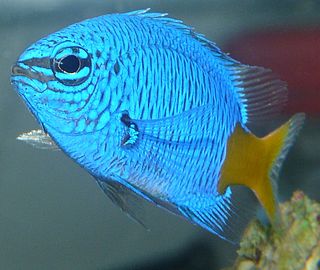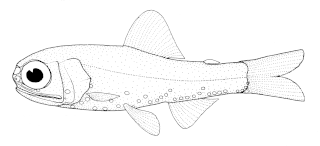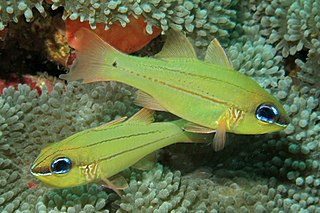 W
WAstroblepus frenatus is a species of catfish of the family Astroblepidae. It can be found in the Magdalena, Orinoco and Catatumbo river basins in Colombia. A. frenatus is a carnivorous speciesand it is a habitat specialist which has a requirement for highly oxygenated water. This means that it is sensitive to changes in oxygenation levels and water temperatures. It may also be affected by the introduced rainbow trout but overall there is very little data about the status of this species.
 W
WAstroblepus micrescens is a species of catfish of the family Astroblepidae. It can be found on the Orinoco River in Venezuela.
 W
WHelcogramma decurrens, known commonly as the black-throated triplefin, is a species of triplefin blenny in the genus Helcogramma. It was described by Allan Riverstone McCulloch and Edgar Ravenswood Waite in 1918. This species occurs along the western and southern coasts of Australia where it is found down to depths of 13 metres (43 ft) in both the intertidal and subtidal zones where it hides among algae growing on rocky substrates.
 W
WThe bullhead triplefin, Trianectes bucephalus, is a fish of the family Tripterygiidae and only member of the genus Trianectes
 W
WChrysiptera parasema, also known as yellowtail damselfish, yellowtail blue damsel, goldtail demoiselle, and other variations, is a popular saltwater aquarium fish from the Indo-Pacific. It was described by Fowler in 1918.
 W
WThe Costello tetra is a species of characin from the Amazon basin and is found in Brazil and Peru. The specific name comes from Lake Hyanuary in Brazil. Other common names used in English are January tetra and green neon. The name "green neon" is also used for Paracheirodon simulans.
 W
WCtenacanthus is a prehistoric cartilaginous fish genus. Remains have been found in the Bloyd Formation in Arkansas, United States and in South America.
 W
WDevario auropurpureus is a small species of danionin fish endemic to Lake Inle in Myanmar. It is a schooling, active, plankton eater. It is of minor commercial importance as an aquarium pet, usually sold under the older name Inlecypris auropurpurea.
 W
WDiaphus holti, the Small lanternfish, is a species of lanternfish found in the Atlantic and Indian Oceans. This species grows to a length of 7.0 centimetres (2.8 in) SL.
 W
WThe firemouth cichlid is a species of cichlid fish native to Central America. They occur in rivers of the Yucatán Peninsula, Mexico, south through Belize and into northern Guatemala.
 W
WThe Japanese angelfish or Japanese pygmy angelfish is a very rare marine angelfish. It has an orangey yellow body with purplish blue spots completed with a bright yellow tail. The spots are larger towards the tail, and the bottom part the rear of the fish gradually becomes purple. The spots also turn from blue to purple towards the tail. They are native to the Ogasawara Islands south of Japan.
 W
WOstorhinchus sealei, Seale's cardinalfish or the cheek-barred cardinalfish, is a species of ray-finned fish, a cardinalfish, from the family Apogonidae. It is an Indo-Pacific species which ranges from Malaysia east to the Solomon Islands, north to southern Japan and south to northwestern Australia, as well as Palau in Micronesia. It is an uncommon species which occurs among branching corals in the sheltered lagoons protected by reefs. It can be found in small to large aggregations low in the water over the reef. It is infrequent below depths of 10 metres (33 ft). They are mouthbrooders which form pairs to mate. During the day thse fish shelter in the reef and they emerge at night to feed on zooplankton and benthic invertebrates. The specific name honours the American ichthyologist Alvin Seale (1871-1958).
 W
WPhyllophryne scortea, the smooth anglerfish, is a species of frogfish endemic to the waters around Australia. This species grows to a length of 10 centimetres (3.9 in) TL. This species is the only known member of its genus.
 W
WRed dwarf rasbora is a species of cyprinid found endemic to Lake Inle in Shan State in Myanmar. It belongs to the genus Microrasbora, which contains two small species of danionins.
 W
WThe sawbwa barb, also known as the Burmese rammy nose, Asian rummynose or rummynose rasbora, is an endangered species of cyprinid fish in the monotypic genus Sawbwa. The species is endemic to Inle Lake in Myanmar (Burma). It grows to a maximum total length of 3.5 cm (1.4 in). Mature males are iridescent silvery-blue with red snout and red lobes to the tail fin; females are duller without red and with a dark pigmentation spot by the anus. The sawbwa barb completely lacks scales.
 W
WThe ring-backed pipefish is a species of pipefish found in the waters of the Indian Ocean off the southern coast of Australia. It occurs on reefs in beds of red and brown algae down to depths of 15 metres (49 ft). This species grows to a length of 22 centimetres (8.7 in) SL. This species is the only known member of its genus.